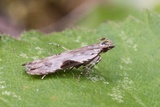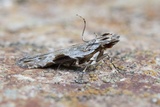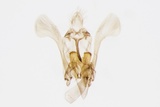Hypatima rhomboidella (Linnaeus, 1758) Species
Last modified: Dec. 27, 2025, 7:11 p.m.
A widespread and fairly common species in Belgium.
Details
- Classification
- Family: Gelechiidae > Subfamily: Anacampsinae > Tribus: Chelariini > Genus: Hypatima > Species: Hypatima rhomboidella
- Vernacular names
- Zandlopermot (NL), Black Rhomboid Grey, Square-spot Sober (EN), Sanduhr-Palpenmotte (DE)
- Synonyms
- Hypatima conscriptella (Hübner, 1805) and Hypatima huebnerella (Donovan, 1806)
- First mention in Belgium
- De Fré Ch. 1858. Catalogue des Microlépidoptères de la Belgique. — Annales de la Société entomologique belge 2: 45–162. On page 137.
- Status
-
Native
Distribution
Caterpillar
Head and prothoracic plate shiny black; thoracic legs black; thoracic segment 2 slightly paler than the rest; abdomen pale green or reddish green, anal plate concolorous with abdomen; pinacula tiny; abdomen becomes suffused pinkish brown shortly before pupation (Gregersen & Karsholt 2022).
Bionomics
Early instars live inside the terminal twigs, causing withering of the leaves, later they live in a rolled leaf, eating half of it before changing to another leaf. Pupation takes places amongst detritus on the ground.
The adults come to light.
Flight periods
The adults have been seen from late June towards late September, occasionally later till late October. Most observations during August.
Observed on
- Host plant (species):
- Corylus avellana and Populus tremula
- Host plant (genera):
- Betula and Alnus
The larva lives on Betula, Populus tremula, alnus or Corylus avellana.
Habitat
It occurs in woodland, parkland, gardens, scrub, heathland and hedgerows.





